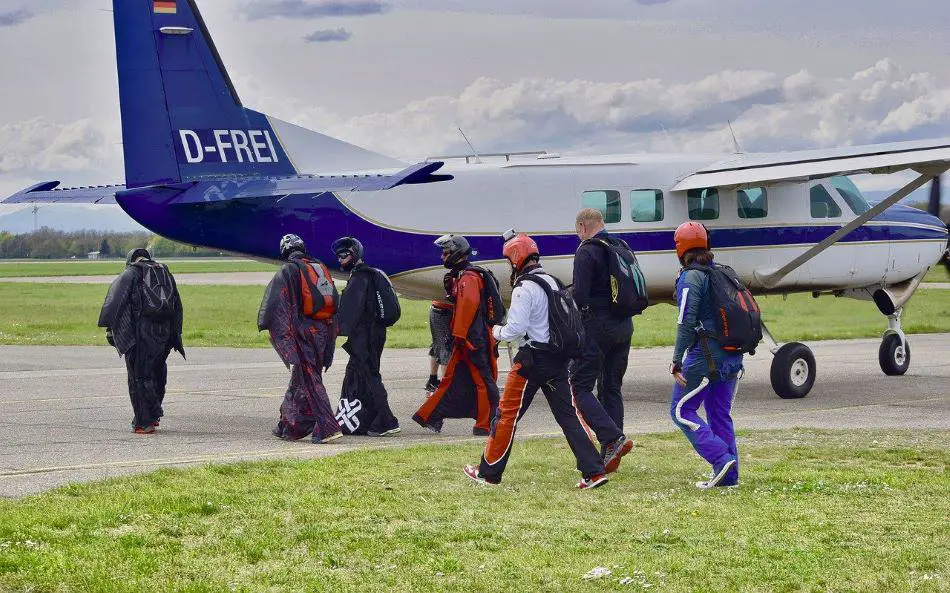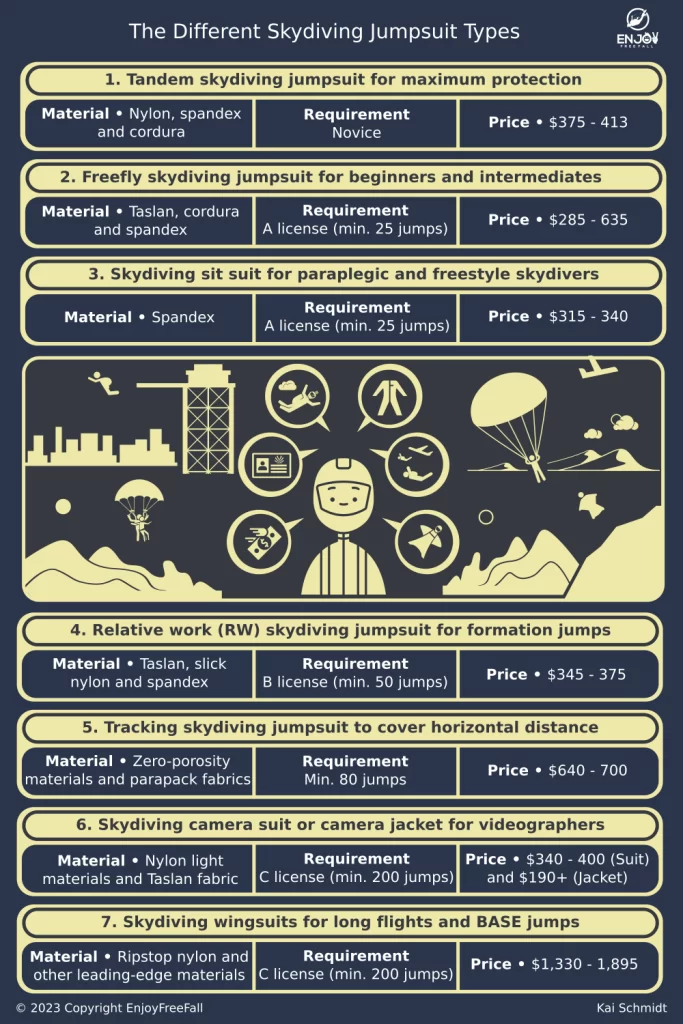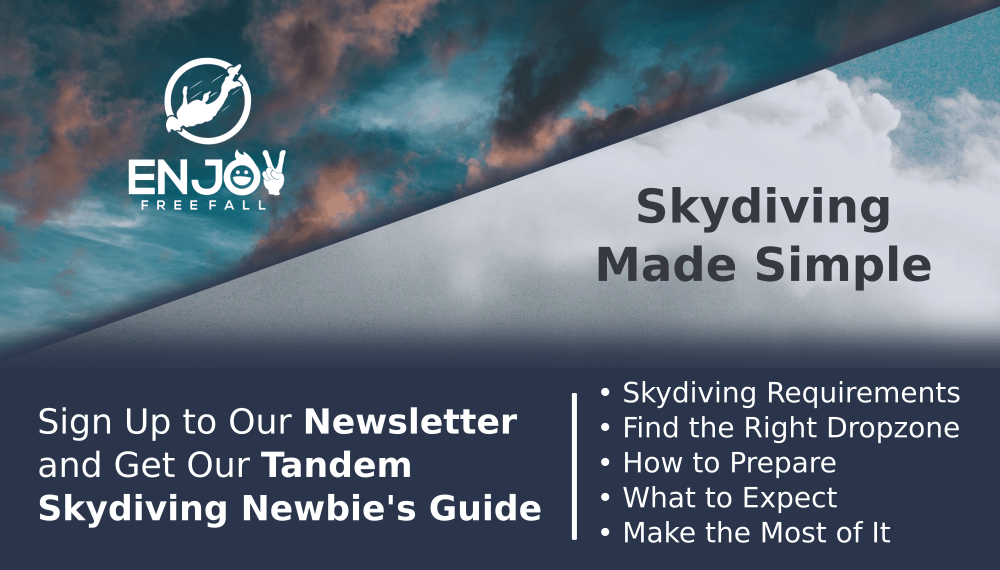
If you’ve ever seen a skydiving video, then you would have seen skydivers freefalling in beautiful, brightly colored suits that contrast them like glowing little insects against the light blue sky. Have you ever wondered “What are these skydiving suits called?”
Typical skydiving suits are called “jumpsuits”. There are special types of skydiving suits such as wingsuits, tandem jumpsuits, and tracking jumpsuits. Each jumpsuit type has different characteristics and is designed for different skydiving disciplines.
In the following post, I have written a complete guide about the different types of suits, when to use them, and why they’re essential. As a bonus, I also reveal occasions when it’s acceptable to take the leap without a jumpsuit.
What Type of Jumpsuits Do Tandem Students and First-Time Skydiver Wear?
Tandem students wear basic skydiving jumpsuits that have slight reinforcements at the knees, butt, and elbows. Tandem suits protect students from minor scratches and abrasions during hard landings since they are made of durable materials.
Skydiving centers provide tandem jumpsuits to their tandem students that come in different colors and sizes.
They also protect the skydiver’s clothes from damage (rips or tears) and possible dirt should they land on the grassy or muddy area of the dropzone. Wearing a jumpsuit will make you look cooler and more professional in skydiving pictures and videos.
If you are unsure what to wear during your first skydive, check out this complete guide to clothing for your first skydive. (I included the five things to wear and not to wear when going skydiving)
What Are the Different Jumpsuit Types And When to Wear Them?
Skydiving jumpsuits come in different designs, colors, and types. Depending on the skydiving discipline, jumpsuits are optimized for different criteria. For example, some skydiving jumpsuits are created to control the fall rate and to increase flying performance while others are designed for extreme weather conditions.
This table presents an overview of skydiving jumpsuits, including their characteristics, usage, materials, wearing regulations, and cost.
| Type of skydiving jumpsuit | Discipline | Materials | Requirements | Price range |
| Tandem Skydiving Jumpsuit | Tandem jumps | Nylon, Spandex, and Cordura | Novice | $375-413 |
| Freefly skydiving jumpsuit | Belly and back flying, tunnel skydiving | Taslan, Cordura, and spandex | A license (min. 25 jumps) | $285-635 |
| Skydiving sit suit | Sit flying | Spandex | A license (min. 25 jumps) | $315-340 |
| Relative Work (RW) skydiving jumpsuit | Formation jumps | Taslan, slick nylon, and Spandex | B license (min. 50 jumps) | $345-375 |
| Tracking skydiving jumpsuit | Tracking | Zero-porosity materials and parapack fabrics | Minimum 80 jumps | $640-700 |
| Skydiving camera suit or camera jacket | Solo and tandem jumps with a videographer | Nylon light materials and Taslan fabric | C license (min. 200 jumps) | $340-400 for the suit and $190+ for the jacket |
| Skydiving wingsuit | BASE jumping, wingsuit skydiving | Ripstop nylon and other leading-edge materials | C license (min. 200 jumps) | $1,330-1,895 |
1. Tandem Skydiving Jumpsuit For Maximum Protection
Tandem suits are worn by tandem instructors and jumpers to protect them from the weather and the possibility of rough landings. They are made of durable materials such as nylon (front area), spandex (sleeves and back area for better flexibility), and Cordura fabrics (elbows and knees) to protect especially tandem students.
Most skydiving centers also customize their tandem suits and include the companies’ names and logos as badges on the suits.
These suits also come in bright colors that are designed to highlight a tandem student’s silhouette against the beautiful blue sky to ensure that they stand out in pictures and videos.
If you’re in search of a comparable exhilarating experience to tandem skydiving, I’ve curated a comprehensive guide outlining 13 activities you will enjoy if you like skydiving. This blog post tackles their unique features and commonalities providing a range of options tailored to your preferences.
2. Freefly Skydiving Jumpsuit For Beginners and Intermediates
The Freefly jumpsuit is ideal for both sky and tunnel flying. It is made of 4-ply Taslan, Cordura, and Spandex to provide for a better fit and to increase mobility. It is great for beginners and intermediate skydivers.
You can opt to upgrade your jumpsuit as your license progresses. Some jumpsuits require you to hold a particular skydiving license before wearing them.
3. Skydiving Sit Suit For Paraplegic and Freestyle Skydivers
The Sit Suit became popular way back in the 90s and is still being used by some skydivers nowadays. It is designed to allow skydivers to maintain a heads-up position (aka sit flying) with the help of large wings on each arm that supports and stabilizes the sitting position.
These suits are mostly made of spandex materials and usually come with short legs, but you can also order sit suits with long spandex legs from some manufacturers.
Some skydivers who experience difficulties in learning the art of heads-up flying wear a sit suit to get an extra drag that helps them to achieve greater stability and to experience longer sit flying.
It is ideal also for freestyle, camera flying, and paraplegic skydivers who need extra drag and arm lift during freefall or deployment.
4. Relative Work (RW) Skydiving Jumpsuit For Formation Jumps
RW Jumpsuits are designed for skydivers who participate in Relative Work Formations (RSW). The front, side, and forearm of the suit are made of 4-fly or sometimes slick nylon, while the back area is made of spandex.
It has grippers and booties (shoe covers) which are important for formation jumps and allow you to easily attach yourself to other skydivers and dive fast toward the appropriate location during formation.
There are 3 types of booties (Standard, Booster, and Competition) that you can choose from depending on the power that you need and looking for:
- Standard booties are easy to control, have plenty of power, and are ideal for those new to the sport.
- Booster booties have a huge amount of power and are much faster in closing long distances during big formations.
- Competition booties are extremely fast, precise, and powerful. They are used during formation competitions.
5. Tracking Skydiving Jumpsuit to Cover Horizontal Distance
Skydivers can choose from either a one-piece or two-piece (jacket and pants) tracking suit. As with parachutes, tracking suits use ram-air inlet technology to inflate the suit for better tracking control and performance.
They are made of zero-porosity materials and parapack fabrics that provide a more aerodynamic shape to the human body by increasing the skydiver’s surface area.
Tracking jumpsuits are ideal for BASE jumping and skydiving since they allow the skydivers to cover longer horizontal distances while reducing the vertical descent rate, enabling skydivers to achieve almost the same results they get when wearing a basic wingsuit.
Tracking jumpsuits are also versatile and comfortable enough that they can be used for hiking or as normal clothing. They also have built-in hoods that protect from rain and other weather conditions apart from pockets that are useful to carry your mobile and radio in.
To qualify for wearing a tracking jumpsuit, skydivers need to complete a minimum of 80 solo jumps.
6. Skydiving Camera Suit or Camera Jacket For Skydiving Videographers
The skydiving videographers who take professional photos and videos during solo or tandem jumps wear specifically designed suits that provide greater flexibility and comfort. They are made of light nylon materials and Taslan fabric.
The outfit comes either as an overall suit or as a jacket, depending on the particular skydiver’s preference.
Camera suit or jacket comes in four wing designs namely:
- A-Wing is the first camera suit introduced in the market. This suit has a medium-sized wing sewn directly under the seam of the mid-forearm up to the waist that is attached using a clip underneath the leg strap. The jacket has a clip loop that needs to be stitched underneath the leg strap with the assistance of a certified rigger. You can also upgrade to a brass R.S.L clip for an extra charge.
- B-Wing is the smallest version of the camera wing with no fastening clip. The small wing is sewn directly under the seam of the forearm up to the waist area of the suit or jacket.
- C-Wing which is the most in-demand camera wing for back flyers. This suit has a medium wing sewn directly to the front of the forearm to give skydivers more support and drag when performing back flying. As with the A-wing suit, it can be attached using a clip underneath the leg strap.
- D-Wing which is the largest camera wingsuit. This suit has a large-sized wing sewn directly under the seam of the mid-forearm up to the mid-thigh and is attached using velcro and a clip underneath the leg strap. For the jacket, the velcro and clip need to be stitched underneath the leg strap with the assistance of a certified rigger.
7. Skydiving Wingsuits For Long Flights And Base Jumps
Skydiving wingsuits are also known as “squirrel suits” since they resemble the wings of a flying squirrel. The suit is made of ripstop nylon and other leading-edge materials to create more surface and reduce drag which provides skydivers with a better glide ability of 3:1 (i.e., 3 meters of glide for every meter of vertical descent).
With the airfoil shape wingsuit, freefall speed can be reduced from 120 mph to 37 mph allowing the wearer to cover a much longer horizontal distance.
Skydivers need to have at least a minimum of 200 jumps and hold a “C” license before they can enroll in a wing-suiting course and start wearing a wingsuit during BASE jumping or skydiving. Wingsuits come in 3 options – beginner, intermediate and advanced.
- Beginner wingsuits are ideal for skydivers with zero wingsuit experience since they have small wings that are designed to gradually introduce skydivers to the world of wingsuit flying. These wingsuits are powerful enough for the beginner while being easy to fly which makes them ideal for novice wingsuit pilots.
- Intermediate wingsuits require at least a minimum of 35 wingsuit jumps. This wingsuit also has a huge amount of power and remains easy to fly, just like the beginner wingsuit. It is perfect for camerawork, head-down flying, belly, and back flying formations.
- Advanced (Expert) wingsuits require a minimum of 200 wingsuit jumps. They are great for competitions, XRW flying and level-up BASE jumping since they are designed to provide maximum power and incredible forward speed to take you where you want to go.
In choosing the most appropriate wingsuit, you need to know the capacity of each model in terms of acrobatics, agility, performance, and cross-relative work (XRW) as well as your own experience level.
If you want to learn more about the inventor of wingsuits and his incredible story, please check out this post.
Reasons for Wearing a Jumpsuit When Skydiving
Like wearing any other skydiving gear, wearing a jumpsuit should be at the top of your to-do list. Here are the reasons why you should wear a jumpsuit when skydiving.
1. Skydiving Jumpsuits Keep You Safe
Jumpsuits are designed to protect skydivers from any accidents or injuries that might arise during landings. That’s why manufacturers have made sure that they are only made with durable, high-quality materials.
Although landing areas are vast and generally flat, even experienced skydivers are not impervious to losing their footing due to strong winds that might destabilize them and cause them to fall. Wearing a jumpsuit can save and protect a skydiver from minor scratches or abrasions.
During tandem jumps, you and your instructor will normally land in a sitting or slide-in position. Your buttocks and leg area might scratch on the ground and to avoid serious injuries it is best if you both wear tandem suits.
However, a jumpsuit is not the only type of equipment that helps keeping skydivers safe, helmets play a significant role. Explore my blog post where I shed light on the essential reasons for wearing a helmet that go beyond head protection. This informative piece also provides insights into the regulations surrounding helmet usage based on location, skill level, and discipline.
2. Skydiving Jumpsuits Are Comfortable to Wear
Most jumpsuits are made with nylon and spandex to provide the wearer with better comfort, increased lightness, and ease of wear. They are available in:
- a one-piece (overall suit) that you can wear on top of your favorite skydiving shirt and pant; or
- a two-piece (jacket and pants) in other cases.
Jumpsuits use breathable materials so wearing a jumpsuit during the summer is still a good idea. The long sleeves and pants protect your body from the cold during winter (although it is recommended that you wear thin layers of thermals underneath).
Some jumpsuits are so comfortable that you can even wear them while hiking or doing other sporting activities.
If you want to learn more about what skydiving jumpsuits are made of (and how it affects your jump), please check this post.
3. Skydiving Jumpsuits Can Increase Your Skydiving Performance
Jumpsuits help control your fall rate as well as your flying performance. Choosing the correct skydiving jumpsuit that suits your needs will aid you in fully enjoying the sport. As you gain experience you can also join competitions.
- Wingsuits are created to give skydivers a longer horizontal glide while decreasing their freefall rate.
- RW jumpsuits allow a skydiver to join formation jumps since they have grippers that are used to easily grab the other skydivers and stay in position.
- Novice skydivers can begin by using a freefly jumpsuit if they are still undecided on which skydiving discipline they want to focus on.
More experienced skydivers even have more than 2 jumpsuits in their closets.

4. Skydiving Jumpsuits Look Cool and Stylish
Jumpsuits allow novice skydivers to look professional in pictures and videos while experienced skydivers may instead choose their jumpsuits based on style, preference, and performance needs.
Typical ways to optimize one look include.
- Choosing a bright, eye-catching color for their jumpsuit.
- Adding custom designs or graphics to their jumpsuit.
- Using accessories such as sunglasses or a helmet to enhance the look.
- Experimenting with different fits, such as baggy or form-fitting styles.
- Accessorizing with gear such as gloves, shoes, or even a parachute canopy in a unique design.
Bonus – How to Save Money When Buying Jumpsuits
Jumpsuits are available either pre-made or through pre-order (with a 5-7 week wait time- depending on the manufacturer).
If you do not wish to buy pre-made jumpsuits, you can go in for customized ones, offered by some manufacturers. You can choose your preferred color, features, and materials for an additional cost. They have a wide range of colors to choose from – bright to dark or even a combination of colors.
If you are tight on the budget and are not yet ready to commit to buying a brand-new jumpsuit, then there are places where you can look for a second-hand jumpsuit.
You can check the Facebook marketplace, join Facebook groups or even check the “Used Skydiving Gear” section of your favorite skydiving stores.
Buying second-hand skydiving jumpsuits can save you anywhere between $150-250 whereas buying a new one will set you back by $285-1895 – depending on the type of jumpsuit.
However, although cheaper, buying secondhand jumpsuits comes with inherent risks so it would be in your best interest to personally inspect the items, check for any wear and tear, and to try it personally to ensure the correct fit.
Instances Where Skydivers Do Not Wear a Jumpsuit
Even though using skydiving jumpsuits is highly recommended, there are certain instances where this practice is not followed. I’ve collated three such instances below.
1. Stratosphere Skydivers Wear A Pressurized “Space” Jumpsuit
Skydivers who have performed stratosphere jumps such as Austrian skydiver Felix Baumgartner and Google Executive Alan Eustace, did not wear the typical skydiving jumpsuits but instead had specialized suits created for them.
Their suits were pressurized “space” jumpsuits that could withstand the cold temperatures and air pressures at the exit altitude. They also came with life support and oxygen supply to make sure that the skydivers were safe throughout their flight.
On 24 October 2014, Google Executive Alan Eustace set a new exit altitude of 135,898 ft (41,422 m). He wore a specialized jumpsuit developed by Paragon Space Development, United Parachute Technologies, and ILC Dover which combined scuba diving technology and NASA spacesuit technology.
They also used the tandem system rig model and instead of a passenger, they put oxygen tanks in the front of the jumpsuit.
This one-of-the-kind record-breaking jumpsuit is now on permanent display at the National Air and Space Museum in Chantilly.
How awesome is that, right? Have you ever wondered if it’s possible to jump higher than that? When I say higher, I mean is it possible to jump from space to earth? I have an article that demystifies whether jumping from the edge of space back down to earth is even viable. This blog post will blow your mind.
2. Some Tandem Students Wear Normal Clothing While Skydiving
Although skydiving centers generally provide tandem suits for students, since body proportions are different, those tandem students who do not fit into the jumpsuits provided can opt to wear normal clothing.
However, they will need to avoid wearing any clothing with zippers, strings, or any outfit that might limit their mobility (e.g., Jeans or skirts)
3. Some Skydivers Even Jump Naked
While it is generally true that experienced skydivers can jump without a jumpsuit and use only their regular clothing, some daredevils are bold enough to jump nude.
There is a tradition in skydiving that you need to do your 100th jump naked and skydivers normally do it just for a good laugh while others do it to celebrate their skydiving milestones.
On 1st March 2020, a group of brave skydivers in Queensland, Australia went skydiving naked to raise awareness and funds for Multiple Sclerosis Queensland.
The lead fundraiser Kaitlyn Sapier had been previously diagnosed with Multiple Sclerosis a few years prior and thought of doing a fundraising activity with the help of her friends in the skydiving community.
They also attempted to break the world record of 23 naked skydivers that had been set 30 years ago but unfortunately, they fell a bit short. The group is still continuing its charity work and hopes to break the world record someday.
Enjoy your freefall!




